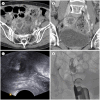Transvaginal Drainage of Pelvic Fluid Collections Unsuitable for Transabdominal Approach
- PMID: 40201615
- PMCID: PMC11973111
- DOI: 10.3348/jksr.2023.0139
Transvaginal Drainage of Pelvic Fluid Collections Unsuitable for Transabdominal Approach
Abstract
Purpose: To evaluate the efficacy and safety of ultrasonography- and fluoroscopy-guided transvaginal catheter drainage for pelvic fluid collection.
Materials and methods: This single-center retrospective study included nine female patients who underwent transvaginal drainage for pelvic fluid collection unsuitable for transabdominal access between October 2016 and January 2023. The study analyzed patient symptoms and signs, ultrasonography and CT findings, transvaginal approach details, and technical and clinical outcomes, including complications. Catheters of size 7 or 8.5-Fr, with or without an endocavitary needle guide were used for the puncture.
Results: Pelvic fluid collections were primarily post-operative (n = 7) or from patients with primary tubo-ovarian abscesses (n = 2). All patients achieved technical success, defined as the successful insertion of the drainage catheter at the site of target fluid collection, and clinical success, defined as the improvement of symptoms with catheter removal within 1 week. In seven cases, the procedure was assisted by an endocavitary needle guide. The median catheter indwelling period was 2 days, with two minor complications: accidental catheter removal and urinary bladder puncture, both of which were managed without further complications.
Conclusion: Ultrasonography- and fluoroscopy-guided transvaginal drainage are effective and safe methods for managing pelvic fluid collections that are unsuitable for a transabdominal approach.
목적: 골반액 저류에 대한 초음파 및 투시 유도 경질배액술의 효과와 안전성을 평가하였다.
대상과 방법: 2016년 10월부터 2023년 1월까지 경복부 접근이 어려운 골반 내 액체 저류에 대하여 초음파 및 투시 유도 경질배액술을 시행 받은 아홉 명의 환자들의 자료를 후향적으로 수집하였다. 환자의 증상 및 징후, 초음파 및 컴퓨터단층촬영 소견, 경질 배액술의 세부사항과 임상 경과를 평가하였으며, 경질 배액술의 기술적 및 임상적 성공률과 합병증 유무에 대해 확인하였다.
결과: 골반 내 액체 저류의 원인으로는 부인과 수술 후 합병증(n = 7) 또는 원발성 자궁난관농양(n = 2) 이었다. 모든 환자에서 목표 위치에 배액 카테터를 성공적으로 삽입하는 것으로 정의되는 기술적 성공과 1주 이내에 카테터 제거로 증상이 호전되는 것으로 정의되는 임상적 성공을 보였고, 일곱 명의 환자에서는 골반액 저류의 정확한 배액을 위하여 endocavitary needle guide를 사용하였다. 경질 카테터의 유치 기간의 중앙값은 2일이었고 두 가지의 경미한 합병증(우발적인 카테터 제거 및 시술 중 방광 천자)이 있었으며 두 경우 모두 추가적인 조치가 필요하지 않았다.
결론: 초음파 및 투시 유도 경질배액술은 경복부 접근으로 골반 내 액체 저류를 배액하기 어려운 경우 이를 치료하는 효과적이고 안전한 방법으로 생각된다.
Keywords: Endocavitary Needle Guide; Pelvic Fluid Collections; Transvaginal Drainage; Ultrasound.
Copyrights © 2025 The Korean Society of Radiology.
Conflict of interest statement
Conflicts of Interest: The authors have no potential conflicts of interest to disclose.
Figures



Similar articles
-
US-guided transvaginal drainage of pelvic abscesses and fluid collections.Radiology. 1991 Oct;181(1):53-6. doi: 10.1148/radiology.181.1.1887056. Radiology. 1991. PMID: 1887056
-
Transrectal and transvaginal catheter drainages and aspirations for management of pelvic fluid collections: technique, technical success rates, and outcomes in 150 patients.Abdom Radiol (NY). 2019 Jul;44(7):2582-2593. doi: 10.1007/s00261-019-01974-9. Abdom Radiol (NY). 2019. PMID: 30868244 Free PMC article.
-
Transvaginal Drainage of Pelvic Abscesses and Collections Using Transabdominal Ultrasound Guidance.Obstet Gynecol Int. 2015;2015:283576. doi: 10.1155/2015/283576. Epub 2015 May 31. Obstet Gynecol Int. 2015. PMID: 26113862 Free PMC article.
-
Transvaginal interventional procedures: aspiration, biopsy, and catheter drainage.Radiographics. 2001 May-Jun;21(3):657-72. doi: 10.1148/radiographics.21.3.g01ma20657. Radiographics. 2001. PMID: 11353114 Review.
-
Interventional radiology in the management of abdominal collections after distal pancreatectomy: a retrospective review.AJR Am J Roentgenol. 2011 Jul;197(1):241-6. doi: 10.2214/AJR.10.5447. AJR Am J Roentgenol. 2011. PMID: 21701036 Review.
References
-
- Saokar A, Arellano RS, Gervais DA, Mueller PR, Hahn PF, Lee SI. Transvaginal drainage of pelvic fluid collections: results, expectations, and experience. AJR Am J Roentgenol. 2008;191:1352–1358. - PubMed
-
- Toglia MR, Pearlman MD. Pelvic fluid collections following hysterectomy and their relation to febrile morbidity. Obstet Gynecol. 1994;83(5 Pt 1):766–770. - PubMed
-
- Eason E, Aldis A, Seymour RJ. Pelvic fluid collections by sonography and febrile morbidity after abdominal hysterectomy. Obstet Gynecol. 1997;90:58–62. - PubMed
-
- Sudakoff GS, Lundeen SJ, Otterson MF. Transrectal and transvaginal sonographic intervention of infected pelvic fluid collections: a complete approach. Ultrasound Q. 2005;21:175–185. - PubMed
-
- Ballard DH, Gates MC, Hamidian Jahromi A, Harper DV, Do DV, D’Agostino HB. Transrectal and transvaginal catheter drainages and aspirations for management of pelvic fluid collections: technique, technical success rates, and outcomes in 150 patients. Abdom Radiol (NY) 2019;44:2582–2593. - PMC - PubMed
LinkOut - more resources
Full Text Sources

